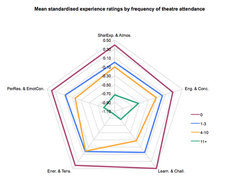 A cluster of theater service organizations in the UK offer an alternative measurement of theatrical success, which they hope counters the current methods of headcounts and box office receipts. The Independent Theatre Council, Society of London Theatre, and Theatrical
A cluster of theater service organizations in the UK offer an alternative measurement of theatrical success, which they hope counters the current methods of headcounts and box office receipts. The Independent Theatre Council, Society of London Theatre, and Theatrical
Management Association — along with the New Economics Foundation — have posted details of the approach and a toolkit to attempt it on-line.
Instead of counting the receipts, or asking patrons whether or not they liked the performance, the approach digs into emotional qualities of the patron’s experience — whether they felt connected, whether they lost track of time, whether they were focused or their minds were wandering. All told, the evaluation suggests five qualities that combine to define the success of a theatrical performance from the audience’s perspective:
- Engagement and concentration
- Learning and challenge
- Energy and tension
- Shared experience and atmosphere
- Personal resonance and emotional connection
The results are gathered and mapped on radar graphs and bar charts (sample shown in this post).
The approach is certainly a welcome alternative to the many hazy and crazy ways we assess live performances. And it’s wonderful for the team to post and share the details and the questionnaires for all to try. But any narrow measure of an aesthetic effort — even an important one like immediate emotional response — provides only a sliver of a glimpse on whether the experience is ”successful” or not. Some experiences take months or years to unfold. Some seem emotionally detached until further experience connects them. Some are never appreciated by a living audience, but cherished by later generations.
It’s great to have another tool in the box. But any good toolbox has more than one.
NOTE: Those interested in measuring intrinsic or emotional responses to artistic experience should also review the earlier work of WolfBrown, also generously shared on the web.


Great idea! Love seeing a creative mind work and gain success!!!!!! Hope it continues to grow!
regards.
http://www.cooperburns.co.uk
All forms of art like theater, visuals, music, and film do, to some extent, follow the trends of business, just like any other consumer item. When there is economic downturn consumers must decide what is necessary for them. However, these art “products” are more personal and are not mass-produced. Thus, the success of these “products” cannot be measured the same as other consumer items. There needs to be some sort of a system to evaluate the success of a performance or a piece, one that is not based off of ticket sales or revenue. The five qualities suggested in this study seem substantial and would definitely evaluate these performances on a more meaningful level. I do not know when these topics can be evaluated though. Directly after the performance? To actually reach the audience and to get them to answer these questions would be difficult. The emotional response to art is much more profound that the immediate sale of a consumer item, but difficult to measure.
Clicking on the links to look at the toolkit, I see that thought the questions are thought provoking, there are a lot of them and they require the participant to concentrate on the questions and the performance itself. If one is able to find an audience willing to participate then the outcomes could be beneficial. Another question at hand is are we are really learning anything new? Those who bought tickets obviously wanted to be there.
This is fascinating material Andrew, thanks for posting it. I don’t think these criteria are perfect, especially the Engagement and concentration along with Learning and challenge; both of which seem geared more toward core attendees than not. Regardless, it is exactly the sorts of benchmarking and evaluation efforts that would benefit the entire arts field.
Lastly, instead of thinking in terms of “success” perhaps a better concept to consider is “impact” and them measuring the latter as it applies to the variety of necessary components (artistic, sales, etc.).